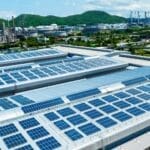
Millions have been left without power from extreme weather events. With recent hurricanes increasing in size and strength, FEMA has laid out recommendations for preparing solar panels to ensure self-reliance in case the grid fails. From the design aspect, one of those recommendations is to implement microinverters versus string inverters when getting your solar panels installed.
Panels experience impediments like cloud coverage, shade from overgrown trees, or even leaves. When it comes to high wind events, most solar panels can withstand up to 140mph of winds, or a Category 4 hurricane, according to NOAA.
However, if one part of an array is impacted by any of these things with a string inverter, all panels will be impacted. Microinverters that attach to each panel prevent a widespread issue. So, for example, when one panel or microinverter fails, the rest of the array is still pumping out power. This is why solar panels designed with optimal operation in mind can help families and businesses stay in play when the power grid goes down.
3 Insights About Microinverters:
- With microinverters, typically, one area failure doesn’t cause an entire system failure. Microinverters that fail only impact the panels they are connected to, unlike string inverters, where the entire system will go down if the inverter is affected.
- An upside to microinverters is that there isn’t one single component powering the entire system. Inverters are one of the first pieces of equipment to fail; microinverters tend to be more dependable because you have more of them.
- Increased productivity – microinverters, on average, have a 3% higher equipment productivity level.
Preparing for an extreme wind event
Most solar panels can withstand up to 140 mph winds, which is around 2,400 pascals (the unit in which solar panel wind resistance is measured). That’s sturdy enough to withstand a Category 4 hurricane, whose wind speeds range from 130 to 156 mph.
Rooftop solar owners can take a series of actions before a strong wind or storm event occurs. We’ve adapted the following list for homeowners based on NREL’s recommendations.
Pre-Storm Solar PV checklist:
- Clear the exterior of all debris and tie down loose items or equipment
- Trim trees and shrubbery that could cause damage to your house or panels
- Install roof drain covers
- Check those drainage systems are cleared and functioning
- Check and have modules, fasteners, and framing tightened
- Check hardware for any corrosion, missing or damaged parts and have them replaced
- Check racking hardware for looseness and have it tightened if needed
- Have professional check electrical, connectors, wiring, J-box, PC cables connections, gasketing, conduit fittings
- While the extreme weather event passes, NREL recommends powering down the system and turning all disconnects to the open position
High-level overview of string inverters and microinverters under extreme weather conditions
In the realm of residential solar systems, the choice between string inverters and microinverters plays a crucial role in determining how these systems perform under extreme weather conditions. String inverters are known for their cost-effectiveness and simplicity, but they can be more vulnerable to extreme weather events. Microinverters operate independently, mitigating the risk of a system-wide failure. This decentralized approach enhances the system’s overall durability during extreme weather, ensuring that even if one panel is compromised, the others continue to function optimally. As a result, homeowners in areas prone to harsh weather conditions may find microinverters to be a more reliable choice for maintaining consistent solar energy production.
The Solar Insure team supports customers on their journey with solar power, and our mission is to deliver the most peace of mind a solar customer can get.
Learn more about what Solar Insure means to homeowners: https://www.solarinsure.com/for-homeowners



